The Automotive Stabilizer Bar Link Market is estimated to be valued at USD 1.6 billion in 2025 and is projected to reach USD 3.4 billion by 2035, registering a compound annual growth rate (CAGR) of 7.6% over the forecast period.
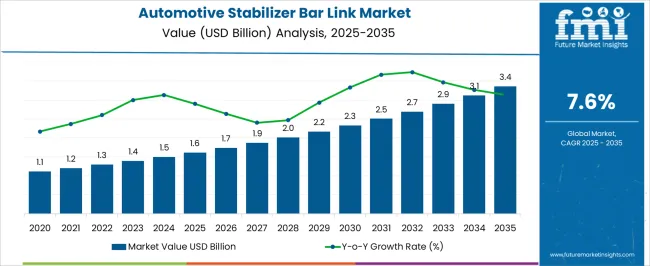
| Metric | Value |
|---|---|
| Automotive Stabilizer Bar Link Market Estimated Value in (2025 E) | USD 1.6 billion |
| Automotive Stabilizer Bar Link Market Forecast Value in (2035 F) | USD 3.4 billion |
| Forecast CAGR (2025 to 2035) | 7.6% |
The Automotive Stabilizer Bar Link market is witnessing steady growth, driven by increasing demand for vehicle safety, improved handling, and rising adoption of advanced suspension systems. Growth is being fueled by the expansion of the passenger car segment, rising vehicle production, and increasing investments in automotive component innovation. The market is also benefiting from the rising replacement demand due to vehicle aging and wear of suspension components.
In addition, stringent safety regulations and performance standards across major automotive markets have prompted manufacturers to adopt high-quality stabilizer bar links to enhance ride stability and minimize body roll. The growth outlook is further supported by advancements in lightweight and high-strength materials, which improve performance and fuel efficiency.
The focus on integrating these components in both passenger and commercial vehicles for improved comfort and safety is expected to create continued opportunities As the automotive industry transitions toward more technologically advanced vehicles, the stabilizer bar link market is poised to maintain robust expansion.
The automotive stabilizer bar link market is segmented by material type, vehicle type, sales channel, and geographic regions. By material type, automotive stabilizer bar link market is divided into Steel, Cast Iron, Aluminium, and Carbon Fibre Reinforced Plastic. In terms of vehicle type, automotive stabilizer bar link market is classified into Passenger Car (PC), Light Commercial Vehicle (LCV), and Heavy Commercial Vehicle (HCV). Based on sales channel, automotive stabilizer bar link market is segmented into Original Equipment Manufacturers (OEM) and Aftermarket. Regionally, the automotive stabilizer bar link industry is classified into North America, Latin America, Western Europe, Eastern Europe, Balkan & Baltic Countries, Russia & Belarus, Central Asia, East Asia, South Asia & Pacific, and the Middle East & Africa.
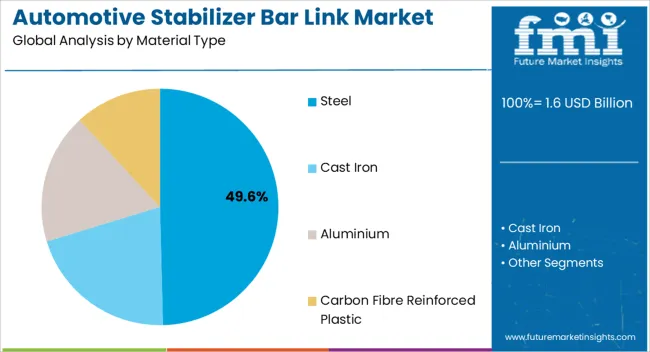
The Steel material type is expected to hold 49.60% of the Automotive Stabilizer Bar Link market revenue share in 2025, making it the leading material type. This prominence is being driven by its high strength, durability, and cost-effectiveness, which make it suitable for withstanding torsional stress and enhancing vehicle stability. Steel components are capable of providing superior load-bearing performance, ensuring long-term reliability in both passenger and commercial vehicles.
Adoption has been reinforced by increasing demand for high-performance suspension systems that maintain structural integrity under varied driving conditions. The recyclability of steel also adds to its appeal in environmentally conscious manufacturing practices.
In addition, manufacturing processes for steel stabilizer bar links are well-established, ensuring consistent quality and widespread availability As vehicle safety and performance requirements continue to evolve, the steel material segment is anticipated to sustain market leadership, driven by its balance of mechanical performance and cost efficiency.
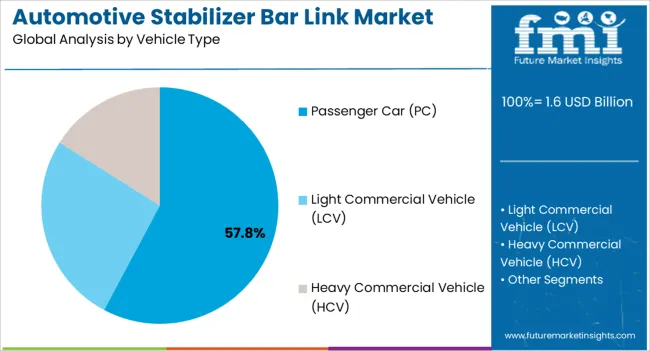
The Passenger Car vehicle type segment is projected to account for 57.80% of the Automotive Stabilizer Bar Link market revenue share in 2025, establishing it as the dominant end-use vehicle category. Growth in this segment is being driven by the increasing production of passenger cars globally, along with rising consumer expectations for improved ride comfort and vehicle handling.
Passenger cars often incorporate advanced suspension systems to enhance driving stability, reduce body roll, and improve safety, which has elevated demand for high-quality stabilizer bar links. Additionally, aging passenger car fleets contribute to aftermarket replacement demand, further supporting revenue growth.
The widespread adoption of lightweight and high-strength materials in passenger vehicles has also encouraged manufacturers to optimize stabilizer bar link designs for better durability and performance As automotive manufacturers continue to focus on safety, comfort, and fuel efficiency, the passenger car segment is expected to maintain a strong lead in stabilizer bar link adoption.
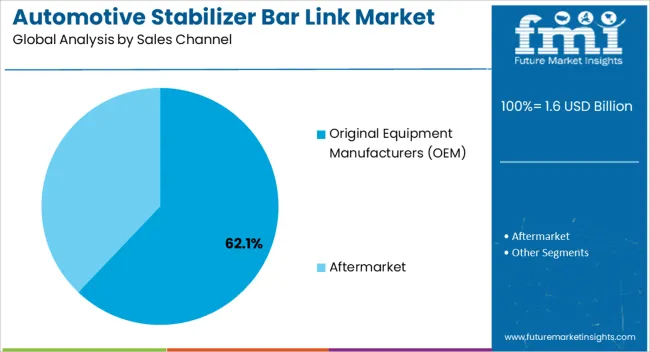
The Original Equipment Manufacturers sales channel segment is expected to hold 62.10% of the Automotive Stabilizer Bar Link market revenue share in 2025, making it the most significant distribution channel. This dominance is being attributed to the direct integration of stabilizer bar links into vehicles during production, ensuring component quality and adherence to performance standards. OEMs provide the advantage of consistent supply, compliance with safety regulations, and compatibility with vehicle-specific suspension systems.
Growth in this segment has been reinforced by the increasing focus of vehicle manufacturers on delivering enhanced handling, safety, and stability as part of their standard offerings. In addition, OEM adoption facilitates long-term partnerships with automotive suppliers, encouraging innovation in high-performance stabilizer bar links.
The ability to bundle components with new vehicles and offer warranty-backed products strengthens customer confidence and drives sales With vehicle production and technological upgrades increasing globally, the OEM channel is expected to retain its market-leading position.
Automotive stabilizer bar link is a component of auto suspension system, which connects various parts that take much of the punishment when the vehicles are being exposed to potholes, pots and road defects. Automotive stabilizer bar link is one of the key components in the vehicle, which maintains a vehicle’s stability on an inclined curve. Automotive stabilizer bar link transmits forces between chassis and bodywork and also ensures maximum driving comfort at all times.
Automotive stabilizer bar link improves the shock and handling absorption, while keeping the car from swaying too much that could lead to loss of control. Adding of stabilizer links between the bars and wheels refines the process control.
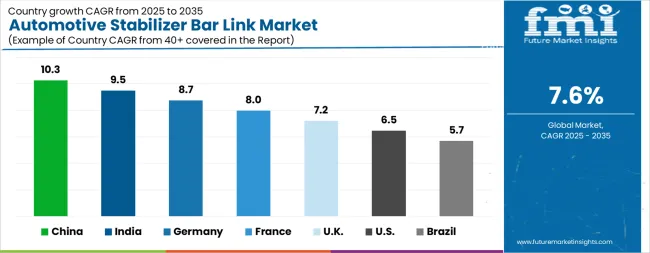
| Country | CAGR |
|---|---|
| China | 10.3% |
| India | 9.5% |
| Germany | 8.7% |
| France | 8.0% |
| UK | 7.2% |
| USA | 6.5% |
| Brazil | 5.7% |
The Automotive Stabilizer Bar Link Market is expected to register a CAGR of 7.6% during the forecast period, exhibiting varied country level momentum. China leads with the highest CAGR of 10.3%, followed by India at 9.5%. Developed markets such as Germany, France, and the UK continue to expand steadily, while the USA is likely to grow at consistent rates. Brazil posts the lowest CAGR at 5.7%, yet still underscores a broadly positive trajectory for the global Automotive Stabilizer Bar Link Market. In 2024, Germany held a dominant revenue in the Western Europe market and is expected to grow with a CAGR of 8.7%. The USA Automotive Stabilizer Bar Link Market is estimated to be valued at USD 563.4 million in 2025 and is anticipated to reach a valuation of USD 1.1 billion by 2035. Sales are projected to rise at a CAGR of 6.5% over the forecast period between 2025 and 2035. While Japan and South Korea markets are estimated to be valued at USD 77.4 million and USD 47.7 million respectively in 2025.
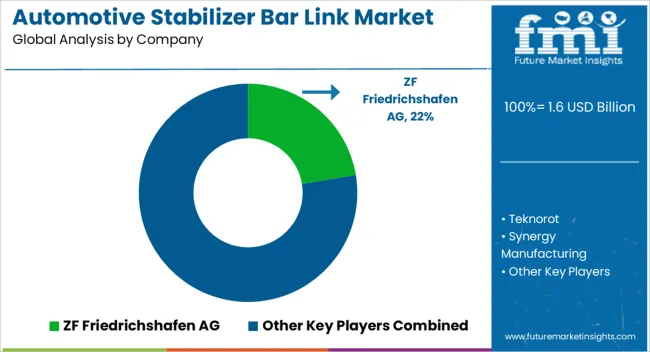
| Item | Value |
|---|---|
| Quantitative Units | USD 1.6 Billion |
| Material Type | Steel, Cast Iron, Aluminium, and Carbon Fibre Reinforced Plastic |
| Vehicle Type | Passenger Car (PC), Light Commercial Vehicle (LCV), and Heavy Commercial Vehicle (HCV) |
| Sales Channel | Original Equipment Manufacturers (OEM) and Aftermarket |
| Regions Covered | North America, Europe, Asia-Pacific, Latin America, Middle East & Africa |
| Country Covered | United States, Canada, Germany, France, United Kingdom, China, Japan, India, Brazil, South Africa |
| Key Companies Profiled | ZF Friedrichshafen AG, Teknorot, Synergy Manufacturing, Ruian Wuhuan Auto Spare Parts, Delphi Technologies, NHK International Corporation, Yangzhou Dongsheng Automotive, Taizhou Yongzheng Automobile Parts, ADDCO Manufacturing Company, Swaytec, SOGEFI Group, Mubea, Hyundai, Wanxiang Group, YOROZU, Kongsberg Automotive, and Tinsley Bridge |
The global automotive stabilizer bar link market is estimated to be valued at USD 1.6 billion in 2025.
The market size for the automotive stabilizer bar link market is projected to reach USD 3.4 billion by 2035.
The automotive stabilizer bar link market is expected to grow at a 7.6% CAGR between 2025 and 2035.
The key product types in automotive stabilizer bar link market are steel, cast iron, aluminium and carbon fibre reinforced plastic.
In terms of vehicle type, passenger car (pc) segment to command 57.8% share in the automotive stabilizer bar link market in 2025.






Full Research Suite comprises of:
Market outlook & trends analysis
Interviews & case studies
Strategic recommendations
Vendor profiles & capabilities analysis
5-year forecasts
8 regions and 60+ country-level data splits
Market segment data splits
12 months of continuous data updates
DELIVERED AS:
PDF EXCEL ONLINE
Automotive Manufacturing Equipment Market Size and Share Forecast Outlook 2025 to 2035
Automotive Pressure Sensor Market Size and Share Forecast Outlook 2025 to 2035
Automotive Vacuum Brake Booster Market Size and Share Forecast Outlook 2025 to 2035
Automotive Smart Antenna Market Size and Share Forecast Outlook 2025 to 2035
Automotive Actuator Market Size and Share Forecast Outlook 2025 to 2035
Automotive Exhaust Manifold Market Size and Share Forecast Outlook 2025 to 2035
Automotive Roof Rails Market Size and Share Forecast Outlook 2025 to 2035
Automotive Resonator Market Size and Share Forecast Outlook 2025 to 2035
Automotive Counter Shaft Market Size and Share Forecast Outlook 2025 to 2035
Automotive Wheel Coating Market Size and Share Forecast Outlook 2025 to 2035
Automotive Water Separation Systems Market Size and Share Forecast Outlook 2025 to 2035
Automotive Refinish Coating Market Size and Share Forecast Outlook 2025 to 2035
Automotive Emission Test Equipment Market Size and Share Forecast Outlook 2025 to 2035
Automotive Tire Market Size and Share Forecast Outlook 2025 to 2035
Automotive Glass Market Size and Share Forecast Outlook 2025 to 2035
Automotive Wire & Cable Material Market Size and Share Forecast Outlook 2025 to 2035
Automotive Camshaft Market Size and Share Forecast Outlook 2025 to 2035
Automotive DC-DC Converter Market Size and Share Forecast Outlook 2025 to 2035
Automotive Key Blank Market Size and Share Forecast Outlook 2025 to 2035
Automotive Tensioner Market Size and Share Forecast Outlook 2025 to 2035

Thank you!
You will receive an email from our Business Development Manager. Please be sure to check your SPAM/JUNK folder too.
Chat With
MaRIA